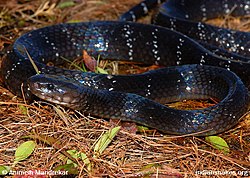| Bungarus bungaroides | |
|---|---|
 | |
| Scientific classification | |
| Kingdom: | Animalia |
| Phylum: | Chordata |
| Class: | Reptilia |
| Order: | Squamata |
| Suborder: | Serpentes |
| Family: | Elapidae |
| Genus: | Bungarus |
| Species: | B. bungaroides |
| Binomial name | |
| Bungarus bungaroides (Cantor, 1839) | |
 | |
| Synonyms | |
Bungarus bungaroides, the northeastern hill krait, is a venomous species of elapid snake. [2]
